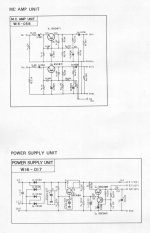Yes, but that stage does not have a base connected straight to ground - unlike your circuit. For an NPN BJT to act as a transistor, it is not sufficient for the emitter to be less positive than the collector - it also has to be less positive than the base so the base-emitter junction is forward biased. As far as I can see your transistor simply has two reverse biased junctions so unless one or both of them enters reverse breakdown it plays no role in the circuit at all.
Yes, but that stage does not have a base connected straight to ground - unlike your circuit. For an NPN BJT to act as a transistor, it is not sufficient for the emitter to be less positive than the collector - it also has to be less positive than the base so the base-emitter junction is forward biased. As far as I can see your transistor simply has two reverse biased junctions so unless one or both of them enters reverse breakdown it plays no role in the circuit at all.
Well explained, Thanks. I will see what I can do to remedy.
Your circuits certainly speak volumes, for those who can read a circuit diagram.
Thanks
Seriously, what a load of bollocks. The way the LED is connected does not in any way affect the sound. Maybe your perception of the sound because you believe it to be better without doing any objective measurements. For all that hassle you could have just used a potentiometer, which would have better tracking (even with the cheapest examples), and none of the low level distortion that LDRs produce.
You don't need any chokes in a linear power supply, in fact they're probably producing some nasty spikes across the rectifier.
Your circuit is probably the most nonsensical one that I've ever seen, stop using Oregano and start using SchemeIt or something web-based that produces acceptable looking schematics.
Seriously though, read up on proper audio design, Elliot Sound Products would be a good start.
You don't need any chokes in a linear power supply, in fact they're probably producing some nasty spikes across the rectifier.
Your circuit is probably the most nonsensical one that I've ever seen, stop using Oregano and start using SchemeIt or something web-based that produces acceptable looking schematics.
Seriously though, read up on proper audio design, Elliot Sound Products would be a good start.
Member
Joined 2009
Paid Member
Another design to steer clear of is the ESP phono stage. Too noisy and too much HF overload.
Seriously though, read up on proper audio design, Elliot Sound Products would be a good start.
What, here on DIYaudio? Whatever next!georgehifi said:Someone is being facetious.
Member
Joined 2009
Paid Member
Wait a second, that's from a completely different thread. Are you stalking me, Bigun?
he he, not really. I don't normally hang out on these sub-forums, I'm mostly to be found in the amplifier discussions. But for some reason your avatar and username caught my attention when I was reading around a little yesterday with some time on my hands
You can also get stable LED current by running a resistor from a voltage source. It is not worth bothering too much about the stability of the illumination source, as the LDR will have some signal-dependent resistance variation anyway.Fenris said:I use a LM134 precision current source to control the current through the LED portion of the LDR. LEDs are current devices after all. Stable current = stable resistance values.
For that reason I am not a fan of LDR volume controls, but if you want one I recommend using a design from someone who knows what he is talking about e.g. someone who knows how to bias a transistor, and understands that the output of an opamp comes from the output pin.
What is the range of currents that you can get from the LM134?
Rudi needs a solution to his new LDR control system.
1uA to 10ma. Power supply range of up to 40v. Perfect for LDRs. I use a 5k pot for control (with 10 ohms in series for safety) which gives me a range of about 15uA to 6 ma. The series LDR uses half of a double 5k linear pot and the shunt LDRs use the other half (wired the opposite way) with a fixed resistor to give a pseudo-log effect. Overall the non-linearities of the control combined with the non-linearity of the LDRs produces a nearly perfect log volume control (at least according to all the math in a big Excel spreadsheet I built). In actual operation it seems to work just right.
- Status
- This old topic is closed. If you want to reopen this topic, contact a moderator using the "Report Post" button.
- Home
- Source & Line
- Analog Line Level
- Good audio with LDR's
